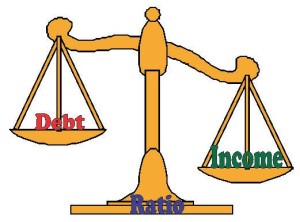What Debts Make Up Debt-To-Income Ratios for
Home Buyers?
Debt to Income ratios is a basic starting point on whether or not a home buyer is able to qualify for a mortgage. As a mortgage lender, I am countering critics who claim small down payment mortgages were a major cause of mortgages failing in the last decade. I have pointed out in the past that it was not low down payments that caused mortgages to fail and homes to go into foreclosure. But the Debt-To-Income (DTI) Ratios home Borrowers were allowed to go to in the past, as well as Borrowers who did not have a good payment history, allowed home buyers to qualify for mortgages that they should not have.
failing in the last decade. I have pointed out in the past that it was not low down payments that caused mortgages to fail and homes to go into foreclosure. But the Debt-To-Income (DTI) Ratios home Borrowers were allowed to go to in the past, as well as Borrowers who did not have a good payment history, allowed home buyers to qualify for mortgages that they should not have.
At one point in the last decade mortgage borrowers were allowed to use up to 67% of their Total Income in qualifying for a mortgage and have credit scores in the low to mid 500’s (which is unheard of now with any lender). No longer is this possible. The combination of these two things were the reason for the failed mortgages not low down payments when buying a home.
As a mortgage broker it is a good idea to further explain in detail What Debts Make Up The Debt-To-Income (DTI) Ratios when qualifying for a mortgage. But before I do let me first start out by stating the Consumer Financial Protection Bureau (CFPB) QM Rule presently limits a Borrower’s DTI to not be higher that 45%. However, the CFPB will soon lower the Total Debt-To-Income Ratio to 43% on all Loan Programs. This is a far cry from the 67% which once was allowed for home buyers qualifying for a mortgage.
A Debt-To-Income Ratios is the Percentage of the Borrower(s) Monthly Debt versus the GROSS Monthly Borrower(s) income. In other words the Borrower(s) Debt divided by Borrower(s) Income = Debt-To-Income Ratio (DTI). For example if the Borrower(s) have $2,000 in Monthly Debt, and $5,000 of Monthly Income works as follows:
For example: $2,000/$5,000 = 40% DTI
Every Borrower(s) has TWO Debt-To-Income Ratios:
- The first is the Housing Ratio, known as the “Front or Top Ratio”
- The second is the Total Debt-To-Income Ratio, known as the “Back or Bottom Ratio”.
The following is what is included in each Ratio. As I list each debt, which is calculated into the Debt-To-Income Ratio’s, I will indicate if the debt is just specific to a particular Loan Program.
Housing Ratio more commonly known as the “Front or Top Ratio” consists of:
- The Loan Principle & Interest
- Property Taxes
- Homeowners Insurance (hazard insurance)
- Homeowners or Condo Association Fees (HOA), if applicable.
- Private Mortgage Insurance (PMI) – Only on Conventional (less than 20% down), or USDA Rural Loans.
- Monthly Insurance Premium (MIP) – Only on FHA Loans
- Down payment Assistance Loans
- Second Mortgage, Line of Credit, if it is done at the same time as the First Mortgage.
Total Debt-To-Income Ratio more commonly known as the “Back or Bottom Ratio” consists of all the debts that were included in the Housing Ratio plus:
- All Monthly Revolving Debt such as:
- Credit Cards
- Loans such as:
- Car Loans
- Student Loans
- Personal Loans
- Second Mortgage, Home Equity, & Line of Credit if not done at the same time as the First Mortgage, or was done at the same time but is being subordinated on a new loan.
- Child Day Care – Only on VA Loans.
- Child Support Payments
- Alimony Payments
- Existing Mortgage Payments (second home, investment property, etc.)
There are exceptions for some of the above debts if they only have a certain amount of payments left, or if a loan is being deferred, which is common of student loans. But as a general rule, the above debts will be include in the Total-Debt-To Income Ratio.
As you can see there are several monthly debts which are not calculated into the Total DTI Ratios such as:
- Food
- Clothing
- Gas
- Utilities
- Entertainment
- Federal & State Income Taxes
- Charitable Contributions
There are other debts not figured in the Total DTI Ratios, but these make up the larger ones. As you can see the taxes we pay in Federal & State taxes alone will take at least 25-30 percent of our income. If DTI Ratios were allowed to go up to 67% of GROSS Income that left Borrowers with 3-8 percent of their income for all the other things you see on the list above.
It does not take a rocket scientist to figure out this was a receipt for failed mortgages. By the way it is the government who force Lenders to lend at such high DTI Ratios. If Lenders deny a loan to a Borrower because they do not like how high the DTI Ratios are, but the Borrower are within the allowed DTI Ratios, the Lender is open to a Banking Commission complaint and a law suite for discrimination.
I hope I have been able to provide the above information on what a Debt-To-Income (DTI) Ratio is, and What Debts Make Up The Debt-To-Income (DTI) Ratios in not only an easy to understand format, but also in a way which makes it clear why so many mortgages failed in the past. It is always a pleasure to be a guest blogger for Ginny Gorman on her Rhode Island real estate web site.
What Debts Make Up Debt-To-Income Ratios for Home Buyers?
****************************************************************************
Info about the post author and guest blogger, George Soutu:
George Souto is a mortgage Loan Officer who can assist you with all your FHA, CHFA, and Conventional mortgage needs in Connecticut. George resides in Middlesex County which includes Middletown, Middlefield, Durham, Cromwell, Portland, Higganum, Haddam, East Haddam, Chester, Deep River, and Essex. George can be contacted at (860) 573-1308 or gsouto@mccuemortgage.com and he knows mortgages.
I appreciate George’s shares on mortgage information in the current real estate times with my web site readers at www.RIHouseHunt.com
Rhode Island real estate agent and licensed RI real estate agent, Ginny Lacey Gorman, helps list homes and waterfront property in Rhode Island at 401-529-7849 or email me at Ginny@RiHouseHunt.com.



